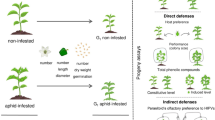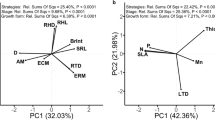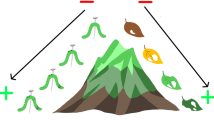Abstract
The evolution of increased competitive ability hypothesis predicts that introduced plants that are long liberated from their natural enemies may lose costly herbivore defense, enabling them to reallocate resources previously spent on defense to traits that increase competitive superiority. We tested this prediction by comparing the competitive ability of native St John's wort ( Hypericum perforatum) from Europe with introduced St John's wort from central North America where plants have long grown free of specialist herbivores, and introduced plants from western North America where plants have been subjected to over 57 years of biological control. Plants were grown in a greenhouse with and without competition with Italian ryegrass ( Lolium multiflorum). St John's wort from the introduced range were not better interspecific competitors than plants from the native range. The magnitude of the effect of ryegrass on St John's wort was similar for introduced and native genotypes. Furthermore, introduced plants were not uniformly larger than natives; rather, within each region of origin there was a high variability in size between populations. Competition with ryegrass reduced the growth of St John's wort by >90%. In contrast, St John's wort reduced ryegrass growth <10%. These results do not support the contention that plants from the introduced range evolve greater competitive ability in the absence of natural enemies.



Similar content being viewed by others
Change history
23 June 2005
An Erratum to this paper has been published: https://doi.org/10.1007/s00442-005-0135-z
References
Anderson S (1989) Life-history variation in Crepis tectorum (Asteraceae) Oecologia 80:540–545
Blossey B, Kamil J (1996) What determines the increased competitive ability of invasive non-indigenous plants? In: Moran VC, Hoffman JH (eds) Proceedings of the IXth International Symposium on Biological Control of Weeds, 19–26 January 1996, Stellenbosch, South Africa. University of Cape Town, Cape Town, pp 19–26
Blossey B, Nötzold R (1995) Evolution of increased competitive ability in invasive non-indigenous plants: a hypothesis. J Ecol 83:887–889
Campbell MH, Delfosse ES (1984) The biology of Australian weeds. 13. Hypericum perforatum. J Aust Inst Agric Sci 50:63–73
Campbell MJ, May CE, Southwell IA, Tomlinson JD, Michael PW (1997) Variation in Hypericum perforatum (St John's wort) in New South Wales. In: Jupp PW, Briese DT, Groves RH (eds) St John's wort: Hypericum perforatum integrated control and management. Plant Prot Q 12:64–66
Goldberg DE (1990) Components of resource competition in plant communities. In: Grace JB, Tilman D (eds) Perspectives of plant competition. Academic Press, New York, pp 27–49
Goldberg DE, Rajaniemi T, Gurevitch J, Stewart-Oaten A (1999) Empirical approaches to quantifying interaction intensity: competition and facilitation along productivity gradients. Ecology 80:1118–1131
Grace JB (1990) On the relationship between plant traits and competitive ability. In: Grace JB, Tilman D (eds) Perspectives of plant competition. Academic Press, New York, pp 51–65
Holloway JK, Huffaker CB (1951) The role of Chrysolina gemellata in the biological control of Klamath weed. J Econ Entomol 44:244–247
Holloway JK, Huffaker CB (1953) Establishment of a root borer and a gall fly for control of Klamath weed. J Econ Entomol 46:65–67
Huffaker CB, Holloway JK (1949) Changes in range plant population structure associated with feeding of imported enemies of Klamath weed ( Hypericum perforatum L.) Ecology 30:167–175
Julien MH, Griffiths MW (1998) Biological control of weeds. A world catalogue of agents and their target weeds, 4th edn. CABI, Wallingford
Keddy PA (2001) Competition, 2nd edn. Kluwer, Dordrecht
Leger EA, Rice KJ (2003) Invasive California poppies (Eschscholzia californica Cham.) grow larger than native individuals under reduced competition. Ecol Lett 6:257–264
Rice KJ, Mack RN (1991) Ecological genetics of Bromus tectorum. 3. The demography of reciprocally sown populations. Oecologia 88:91–101
Siemann E, Rogers WE (2001) Genetic differences in growth of an invasive tree species. Ecol Lett 4:514–518
Thébauld C, Simberloff D (2001) Are plants really larger in their introduction ranges? Am Nat 156:231–236
Weber E (1997) Phenotypic variation of the introduced perennial Solidago gigantea in Europe. Nord J Bot 17:631–638
Weiner J (1990) Asymmetric competition in plant populations. Trends Ecol Evol 5:360–364
Willis AJ, Blossey B (1999) Benign climates do not explain the increased plant size of non-indigenous plants: a cross-continental transplant experiment. Biocontr Sci Technol 9:567–577
Willis AJ, Memmott J, Forrester RI (2000) Is there evidence for the post-invasion evolution of increased size among invasive plant species? Ecol Lett 3:275–283
Zar JH (1984) Biostatistical analysis. Prentice-Hall, Englewood Cliffs, N.J., USA
Acknowledgements
We are tremendously grateful to A. Angert, D. Ayers, J. Combs, U. Gamper, S. Gardner, D. Greiling, F. Grevstad, J. Hess, R. Keller, P. Kittelson, E. Knapp, E. Ogheri, P. Pysek, A. Sears, R. Sobhian, A. Stanley, J. Taft, E. Weber, A. Weis and A. Wolf for collecting St John's wort seeds for us. The experiment was conducted at the Universitat de Barcelona greenhouse facilities. We thank I. Gimeno, L. Marco and J. Matas for greenhouse assistance and C. Daehler for comments on an early draft of the paper. This study was partially funded by grants from the University of Washington and NSF grant DB00-98377 to J. L. M. and by DGICYT (REN2000–0361/GLO) to M. V.
Author information
Authors and Affiliations
Corresponding author
Rights and permissions
About this article
Cite this article
Vilà, M., Gómez, A. & Maron, J.L. Are alien plants more competitive than their native conspecifics? A test using Hypericum perforatum L.. Oecologia 137, 211–215 (2003). https://doi.org/10.1007/s00442-003-1342-0
Received:
Accepted:
Published:
Issue Date:
DOI: https://doi.org/10.1007/s00442-003-1342-0




